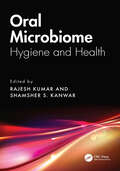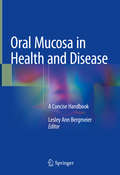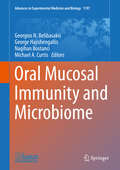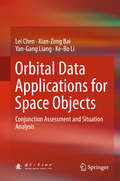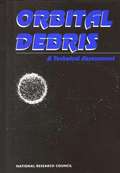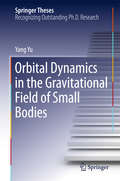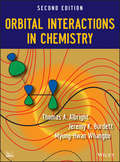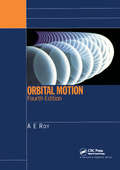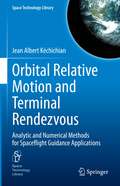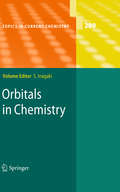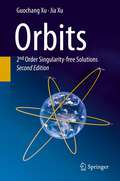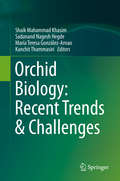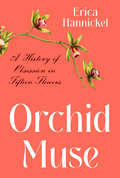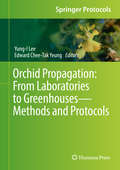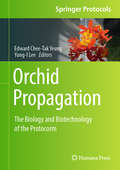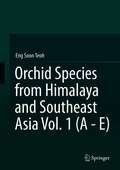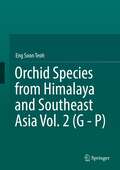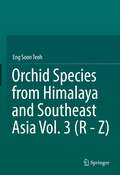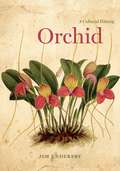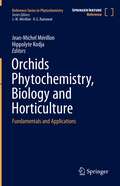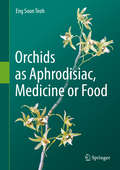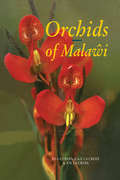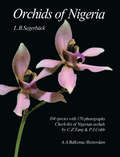- Table View
- List View
Oral Microbiome: Hygiene and Health
by Rajesh Kumar Shamsher S. KanwarThis book comprehensively reviews the intricate and multifaceted role of the oral microbiome in overall health and well-being. The introductory chapters present the diverse bacterial consortium inhabiting the oral cavity and the influence of dietary habits on the nature of the oral microbiome. The book investigates the link between the gut microbiome and susceptibility to disease, expanding the understanding of the interconnectedness of the human microbiota. Further, the book discusses the involvement of the oral microbiome in acute and chronic infections and addresses the concerning issue of drug resistance within this complex environment. It unveils the connection between the oral microbiome and mouth cancer and malignancies, presenting critical insights into disease prevention and management. The book also expands the scope, examining the role of the oral microbiome in systemic infections and revealing connections between oral bacteria and cardiac diseases. Towards the end, the book explores the pivotal role of oral microbiota in children’s well-being and reviews the various diagnostic techniques associated with the oral microbiome. This book is intended for researchers in the fields of microbiology and immunology, dentists, oral health specialists, physicians, and health care practitioners.
Oral Mucosa in Health and Disease
by Lesley Ann BergmeierThis book is designed to re-establish the position of the oral cavity and its mucosa at the forefront of defence and maintenance of homeostatic mechanisms that protect against disease not just locally but also systemically. The oral mucosa is a unique collection of tissues that constitutes a highly active environment with its own unique microflora and homeostatic interaction with the innate and adaptive immune responses. As an immune tissue the oral mucosa was somewhat neglected in the past owing to the tendency to assume similarity to the gut mucosa. More recently it has become apparent that the oral mucosa is a complex environment and, like the esophageal mucosa, has more in common with vaginal tissue than with the gut. Furthermore, the ability of the oral mucosa to act as an immune inductive site has made it an attractive area of research in terms of desensitization for allergic reactions and possibly autoimmune responses. In this book, recognized experts in the field provide up-to-date coverage of all aspects of the structure and function of the oral mucosa, reflecting important recent advances in knowledge, including at the molecular level.
Oral Mucosal Immunity and Microbiome (Advances in Experimental Medicine and Biology #1197)
by George Hajishengallis Nagihan Bostanci Georgios N. Belibasakis Michael A. CurtisThe first International Conference on Oral Mucosal Immunity and Microbiome (OMIM) aimed to highlight cutting-edge basic and translational research from an oral immunological and microbiological perspective. Oral diseases with a microbial etiology are the most prevalent chronic diseases of humans. Whilst not life-threatening, they can significantly compromise quality of life, are associated with increased risk for certain systemic diseases, and pose heavy financial burdens to national health systems. Hence, periodontal and peri-implant diseases, dental caries, root canal infections and mucosal infections are significant global public health problems.In this book global experts summarize and discuss the latest progress made in oral mucosal immunity and the oral microbiome. Target audience is basic and/or translational researchers with expertise in host immunity and microbiome research, and interest in oral health and disease. This volume provides a much needed quantum leap in the field, by joining forces to address gaps at the oral mucosal immunity-microbiome cross-talk.
Orbit and Rotation: Science Logbook (PhD Science™ #Level 5, Module 4)
by Great MindsNIMAC-sourced textbook
Orbital Data Applications for Space Objects
by Lei Chen Xian-Zong Bai Yan-Gang Liang Ke-Bo LiThis book introduces readers to the application of orbital data on space objects in the contexts of conjunction assessment and space situation analysis, including theories and methodologies. It addresses the main topics involved in space object conjunction assessment, such as: orbital error analysis of space objects; close approach analysis; the calculation, analysis and application of collision probability; and the comprehensive assessment of collision risk. In addition, selected topics on space situation analysis are also presented, including orbital anomaly and space event analysis, and so on. The book offers a valuable guide for researchers and engineers in the fields of astrodynamics, space telemetry, tracking and command (TT&C), space surveillance, space situational awareness, and space debris, as well as for graduates majoring in flight vehicle design and related fields.
Orbital Debris: A Technical Assessment
by Committee on Space DebrisSince the beginning of space flight, the collision hazard in Earth orbit has increased as the number of artificial objects orbiting the Earth has grown. Spacecraft performing communications, navigation, scientific, and other missions now share Earth orbit with spent rocket bodies, nonfunctional spacecraft, fragments from spacecraft breakups, and other debris created as a byproduct of space operations. Orbital Debris examines the methods we can use to characterize orbital debris, estimates the magnitude of the debris population, and assesses the hazard that this population poses to spacecraft. Potential methods to protect spacecraft are explored. The report also takes a close look at the projected future growth in the debris population and evaluates approaches to reducing that growth. Orbital Debris offers clear recommendations for targeted research on the debris population, for methods to improve the protection of spacecraft, on methods to reduce the creation of debris in the future, and much more.
Orbital Dynamics in the Gravitational Field of Small Bodies
by Yang YuThis prizewinning PhD thesis presents a general discussion of the orbital motion close to solar system small bodies (SSSBs), which induce non-central asymmetric gravitational fields in their neighborhoods. It introduces the methods of qualitative theory in nonlinear dynamics to the study of local/global behaviors around SSSBs. Detailed mechanical models are employed throughout this dissertation, and specific numeric techniques are developed to compensate for the difficulties of directly analyzing. Applying this method, several target systems, like asteroid 216 Kleopatra, are explored in great detail, and the results prove to be both revealing and pervasive for a large group of SSSBs.
Orbital Interactions in Chemistry
by Jeremy K. Burdett Myung-Hwan Whangbo Thomas A. AlbrightExplains the underlying structure that unites all disciplines in chemistryNow in its second edition, this book explores organic, organometallic, inorganic, solid state, and materials chemistry, demonstrating how common molecular orbital situations arise throughout the whole chemical spectrum. The authors explore the relationships that enable readers to grasp the theory that underlies and connects traditional fields of study within chemistry, thereby providing a conceptual framework with which to think about chemical structure and reactivity problems.Orbital Interactions in Chemistry begins by developing models and reviewing molecular orbital theory. Next, the book explores orbitals in the organic-main group as well as in solids. Lastly, the book examines orbital interaction patterns that occur in inorganic-organometallic fields as well as cluster chemistry, surface chemistry, and magnetism in solids.This Second Edition has been thoroughly revised and updated with new discoveries and computational tools since the publication of the first edition more than twenty-five years ago. Among the new content, readers will find:Two new chapters dedicated to surface science and magnetic propertiesAdditional examples of quantum calculations, focusing on inorganic and organometallic chemistryExpanded treatment of group theoryNew results from photoelectron spectroscopyEach section ends with a set of problems, enabling readers to test their grasp of new concepts as they progress through the text. Solutions are available on the book's ftp site.Orbital Interactions in Chemistry is written for both researchers and students in organic, inorganic, solid state, materials, and computational chemistry. All readers will discover the underlying structure that unites all disciplines in chemistry.
Orbital Mechanics and Astrodynamics: Techniques and Tools for Space Missions
by Gerald R. HintzNow in an updated second edition, this classroom-tested textbook covers fundamental and advanced topics in orbital mechanics and astrodynamics designed to introduce readers to the basic dynamics of space flight. The book explains concepts and engineering tools a student or practicing engineer can apply to mission design and navigation of space missions. Through highlighting basic, analytic, and computer-based methods for designing interplanetary and orbital trajectories, the text provides excellent insight into astronautical techniques and tools. The second edition includes new material on the observational basics of orbit determination, information about precision calculations for data used inflight, such as Mars 2020 with the Ingenuity Helicopter, and improvements in mission design procedures, including the automated design of gravity-assist trajectories. Orbital Mechanics and Astrodynamics: Techniques and Tools for Space Missions is ideal for students in astronautical or aerospace engineering and related fields, as well as engineers and researchers in space industrial and governmental research and development facilities, as well as researchers in astronautics.
Orbital Motion
by A.E. RoyLong established as one of the premier references in the fields of astronomy, planetary science, and physics, the fourth edition of Orbital Motion continues to offer comprehensive coverage of the analytical methods of classical celestial mechanics while introducing the recent numerical experiments on the orbital evolution of gravitating masses and the astrodynamics of artificial satellites and interplanetary probes. Following detailed reviews of earlier editions by distinguished lecturers in the USA and Europe, the author has carefully revised and updated this edition. Each chapter provides a thorough introduction to prepare you for more complex concepts, reflecting a consistent perspective and cohesive organization that is used throughout the book. A noted expert in the field, the author not only discusses fundamental concepts, but also offers analyses of more complex topics, such as modern galactic studies and dynamical parallaxes. New to the Fourth Edition: * Numerous updates and reorganization of all chapters to encompass new methods * New results from recent work in areas such as satellite dynamics * New chapter on the Caledonian symmetrical n-body problem Extending its coverage to meet a growing need for this subject in satellite and aerospace engineering, Orbital Motion, Fourth Edition remains a top reference for postgraduate and advanced undergraduate students, professionals such as engineers, and serious amateur astronomers.
Orbital Relative Motion and Terminal Rendezvous: Analytic and Numerical Methods for Spaceflight Guidance Applications (Space Technology Library #39)
by Jean Albert KéchichianThis book provides a comprehensive analysis of time-fixed terminal rendezvous around the Earth using chemical propulsion.The book has two main objectives. The first is to derive the mathematics of relative motion in near-circular orbit when subjected to perturbations emanating from the oblateness of the Earth, third-body gravity, and atmospheric drag. The mathematics are suitable for quick trajectory prediction and the creation of computer codes and efficient software to solve impulsive maneuvers and fly rendezvous missions.The second objective of this book is to show how the relative motion theory is applied to the exact precision-integrated, long-duration, time-fixed terminal rendezvous problem around the oblate Earth for the general elliptic orbit case.The contents are both theoretical and applied, with long-lasting value for aerospace engineers, trajectory designers, professors of orbital mechanics, and students at the graduate level and above.
Orbitals in Chemistry
by Satoshi InagakiAimed at chemists in both academia and industry, and written by world-renowned experts in their fields, this text, made up of concise yet authoritative reports, is part of a series that presents critical reviews of current ideas and future trends in research.
Orbits
by Guochang Xu Jia XuThe development of the orbits theory lags behind the development of satellite technology. This book provides, for the first time in the history of human satellite development, the complete third order solution of the orbits under all possible disturbances. It describes the theory of satellite orbits, derives the complete solutions of the orbital disturbances, describes the algorithms of orbits determination based on the theory, describes the applications of the theory to the phenomenon of the satellite formation physically. The subjects include: Orbits Motion Equations, Disturbance theory, Solutions of the differential Equations, Algorithms of Orbits determinations, Applications of the theory to the satellite formation.
Orchid Biology: Recent Trends & Challenges
by Shaik Mahammad Khasim Sadanand Nagesh Hegde María Teresa González-Arnao Kanchit ThammasiriThis book on “Orchid Biology: Recent Trends & Challenges” reviews the latest strategies for the preservation and conservation of orchid diversity and orchid germplasm. It is an outcome of the Proceedings of the International Symposium on “Biodiversity of Medicinal Plants & Orchids: Emerging Trends and Challenges” held on 9-11 February 2018 at Acharya Nagarjuna University, India. In addition, eminent orchid experts from around the globe were invited to contribute to this book. All chapters were peer-reviewed by international experts. The Orchidaceae are one of the largest families of flowering plants, comprising over 700 genera and 22,500 species and contributing roughly 40 percent of monocotyledons. They also represent the second-largest flowering plant family in India, with 1,141 species in 166 genera, and contribute roughly 10% of Indian flora. Orchids comprise a unique group of plants and their flowers are among the most enchanting and exquisite creations of nature. Phylogenetically and taxonomically, the Orchidaceae are considered to be a highly evolved family among angiosperms. They show incredible diversity in terms of the shape, size and colour of their flowers, and are of great commercial importance in floriculture markets around the globe. Millions of cut flowers of Cymbidium, Dendrobium, Cattleya, Paphiopedilum, Phalaenopsis, Vanda etc., besides potted orchid plants, are sold in Western Countries and thus, the orchid cut flower industry has now become a multimillion-dollar business in Europe, the USA and South East Asia. Besides their ornamental value, orchids hold tremendous pharmaceutical potential. Root tubers of Habenaria edgeworthii form an important component of the ‘Astavarga’ group of drugs in Ayurvedic medicine. It is an established fact that tubers of some terrestrial orchids have been used to treat diarrhoea, dysentery, intestinal disorders, cough, cold and tuberculosis. Some orchids, particularly those belonging to the genera Aerides, Arachnis, Cattleya, Cymbidium, Dendrobium, Epidendrum, Oncidium, Paphiopedilum, Phalaenopsis, Renanthera, Vanda etc. have been extensively used to produce internationally acclaimed hybrids. Yet paradoxically, Indian orchids are victims of their own beauty and popularity. As a result, their natural populations have been declining rapidly because of unbridled commercial exploitation in India and abroad. In fact, some orchids are now at the verge of extinction, e.g. Renanthera imschootiana, Diplomeris hirsuta, Paphiopedilum fairrieanum, Cypripedium elegans, Taeniophylum andamanicum etc. Given the global importance of orchids in terms of securing human health and wealth, this comprehensive compilation, prepared by international experts, is highly topical. Its content is divided into five main sections: (I) Cryopreservation & Biotechnology, (II) Orchid Biodiversity & Conservation, (III) Anatomy & Physiology, (IV) Pollination Biology and (V) Orchid Chemicals & Bioactive Compounds. All contributions were written by eminent orchid experts/professors from around the world, making the book a valuable reference guide for all researchers, teachers, orchid enthusiasts, orchid growers and students of biotechnology, botany, pharmaceutical sciences and ethnomedicine. It will be equally valuable for readers from the horticultural industry, especially the orchid industry, agricultural scientists and policymakers.
Orchid Muse: A History Of Obsession In Fifteen Flowers
by Erica HannickelOne of Literary Hub's Most Anticipated Books of 2022 A kaleidoscopic journey into the world of nature’s most tantalizing flower, and the lives it has inspired. The epitome of floral beauty, orchids have long fostered works of art, tales of adventure, and scientific discovery. Tenacious plant hunters have traversed continents to collect rare specimens; naturalists and shoguns have marveled at orchids’ seductive architecture; royalty and the smart set have adorned themselves with their allure. In Orchid Muse, historian and home grower Erica Hannickel gathers these bold tales of the orchid-smitten throughout history, while providing tips on cultivating the extraordinary flowers she features. Consider Empress Eugenie and Queen Victoria, the two most powerful women in nineteenth-century Europe, who shared a passion for Coelogyne cristata, with its cascading, fragrant white blooms. John Roebling, builder of the Brooklyn Bridge, cultivated thousands of orchids and introduced captivating hybrids. Edmond Albius, an enslaved youth on an island off the coast of Madagascar, was the first person to hand-pollinate Vanilla planifolia, leading to vanilla’s global boom. Artist Frida Kahlo was drawn to the lavender petals of Cattleya gigas and immortalized the flower’s wilting form in a harrowing self-portrait, while more recently Margaret Mee painted the orchids she discovered in the Amazon to advocate for their conservation. The story of orchidomania is one that spans the globe, transporting readers from the glories of the palace gardens of Chinese Empress Cixi to a seedy dime museum in Gilded Age New York’s Tenderloin, from hazardous jungles to the greenhouses and bookshelves of Victorian collectors. Lush and inviting, with radiant full-color illustrations throughout, Orchid Muse is the ultimate celebration of our enduring fascination with these beguiling flowers.
Orchid Propagation: From Laboratories To Greenhouses - Methods And Protocols (Springer Series in Translational Stroke Research)
by Yung-I Lee Edward Chee-Tak YeungThe orchid family is one of the largest families of flowering plants known for their beauty and economic importance. This work provides information in key areas of research that are important to both scientists and commercial growers alike. The main purposes of this book are to provide key practical areas of research, such as, germination, micropropagation, traditional and current techniques related to plant improvement; document methods that ensure survival of plants from laboratories to greenhouses; promote communication between scientists and growers, so that their combined expertise on these areas will lead to the successful growth of orchids in their natural habitats or commercial greenhouses. This book can serve as reference for laymen with an interest in orchid growing.This book is divided into 5 parts. The first part emphasizes propagation methods using seeds and related techniques that are important to plant conservation and improvement. Successes in asymbiotic and symbiotic seed germination are keys to orchid conservation and their propagation. The second part summarizes micropropagation methods, common media, and newer methods of micropropagation such as the bioreactor culture procedures. The third part focuses on techniques related to the manipulation of explants in an in vitro environment. The fourth part covers cell biological methods and transformation techniques. Since the successes in a laboratory setting do not guarantee plant survival and propagation in greenhouses and in the natural environment, it discusses greenhouse propagation techniques that are essential to the survival of plants generated from a laboratory setting. The fifth part showcases recent successes on orchid propagation by documenting sample publications and how to present orchids in an artistic fashion for one’s enjoyment.
Orchid Propagation: The Biology and Biotechnology of the Protocorm (Springer Protocols Handbooks)
by Yung-I Lee Edward Chee-Tak YeungThis volume provides the first discussion of orchid protcorm and propagation, detailing genome editing research and offers orchid conservation and ecology. Chapters emphasize both the theory and practice of protocorm manipulation, describing protocorm's biology, and a range of related topics useful in studying protocorm. Authoritative and cutting-edge, Orchid Propagation: The Biology and Biotechnology of the Protocorm aims to be a useful practical guide to researches to help further their study in this field.
Orchid Species from Himalaya and Southeast Asia Vol. 1 (A - E)
by Eng Soon TeohA presentation of 491 popular orchid species with 13 varieties and 3 natural hybrids in 51 genera with names beginning with A to E carefully detailed with beautiful photographs and concise descriptions of the plants, their distribution and habitats by a well-known author and photographer. Each genus is assigned a separate chapter. Coverage of the most commonly cultivated Asian species including their varieties and cultivars (e.g. in Bulbophyllum 82 species; Coelogyne 37 species; Dendrobium 210 species) is exhaustive. The orchids are photographed from their best perspective as individual blooms or entire inflorescences. Many species are also shown growing in their natural habitat. Representative hybrids are included to illustrate how some species have contributed to show-worthiness of various genera, their adaptation to a wider climate range, and easy cultivation. This book is a pleasure to view; simultaneously, an easy reference for the identification of orchid species and it provides a guide on how best to grow them. Nowhere else will one find so many popular species beautifully illustrated in a single volume.Volume 1 is the first of a 3 Volume series that will showcase over 900 species plus varieties in 117 genera. A must for everyone fascinated by orchids or simply with a love for nature.
Orchid Species from Himalaya and Southeast Asia Vol. 2 (G - P)
by Eng Soon TeohA presentation of over 700 popular orchid species in 104 genera carefully detailed with beautiful photographs and concise descriptions of plants, their distribution and habitats by a well-known author and photographer. Each genus is assigned a separate chapter. Coverage of the most commonly cultivated Asian species including their varieties and cultivars (e.g. in Bulbophyllum 72 species; Coelogyne 33 species; Dendrobium 161 species; Paphiopedilum 58 species; Phalaenopsis 60 species; Vanda 44 species) is exhaustive. The orchids are photographed from their best perspective, individual blooms and entire inflorescence: additionally, many species are also shown growing in their natural habitat. Representative hybrids are included to illustrate how some species have contributed to show-worthiness of various genera, their adaptation to a wider climate range, and easy cultivation. This book is a pleasure to view; simultaneously, an easy reference for the identification of orchid species and it provides a guide on how best to grow them. Nowhere else will one find so many popular species beautifully illustrated in a single volume.A must for everyone fascinated by orchids or with a love for nature.
Orchid Species from Himalaya and Southeast Asia Vol. 3 (R - Z)
by Eng Soon TeohA presentation of over 700 popular orchid species in 104 genera carefully detailed with beautiful photographs and concise descriptions of plants, their distribution and habitats by a well-known author and photographer. Each genus is assigned a separate chapter. Coverage of the most commonly cultivated Asian species including their varieties and cultivars (e.g. in Bulbophyllum 72 species; Coelogyne 33 species; Dendrobium 161 species; Paphiopedilum 58 species; Phalaenopsis 60 species; Vanda 44 species) is exhaustive. The orchids are photographed from their best perspective, individual blooms and entire inflorescence: additionally, many species are also shown growing in their natural habitat. Representative hybrids are included to illustrate how some species have contributed to show-worthiness of various genera, their adaptation to a wider climate range, and easy cultivation. This book is a pleasure to view; simultaneously, an easy reference for the identification of orchid species and it provides a guide on how best to grow them. Nowhere else will one find so many popular species beautifully illustrated in a single volume.A must for everyone fascinated by orchids or with a love for nature.
Orchid: A Cultural History
by Jim EndersbyAt once delicate, exotic, and elegant, orchids are beloved for their singular, instantly recognizable beauty. Found in nearly every climate, the many species of orchid have carried symbolic weight in countless cultures over time. The ancient Greeks associated them with fertility and thought that parents who ingested orchid root tubers could control the sex of their child. During the Victorian era, orchids became deeply associated with romance and seduction. And in twentieth-century hard-boiled detective stories, they transformed into symbols of decadence, secrecy, and cunning. What is it about the orchid that has enthralled the imagination for so many centuries? And why do they still provoke so much wonder? Following the stories of orchids throughout history, Jim Endersby divides our attraction to them into four key themes: science, empire, sex, and death. When it comes to empire, for instance, orchids are a prime example of the exotic riches sought by Europeans as they shaped their plans for colonization. He also reveals how Charles Darwin's theory of evolution became intimately entangled with the story of the orchid as he investigated their methods of cross-pollination. As he shows, orchids--perhaps because of their extraordinarily diverse colors, shapes, and sizes--have also bloomed repeatedly in films, novels, plays, and poems, from Shakespeare to science fiction, from thrillers to elaborate modernist novels. Featuring many gorgeous illustrations from the collection of the Royal Botanic Gardens, Kew, Orchid: A Cultural History tells, for the first time, the extraordinary story of orchids and our prolific interest in them. It is an enchanting tale not only for gardeners and plant collectors, but anyone curious about the flower's obsessive hold on the imagination in history, cinema, literature, and more.
Orchids Phytochemistry, Biology and Horticulture: Fundamentals and Applications (Reference Series in Phytochemistry)
by Jean-Michel Mérillon Hippolyte KodjaThis reference work provides an authoritative and comprehensive review of the latest developments in orchids’ biology, biotechnology and phytochemistry, and it also explores the applications of orchids in medicinal chemistry, nutrition and cosmetics industry. Chapters from expert contributors are organised into six sections and cover the entire gamut of orchid research and uses. In this work, readers will learn about topics such as biogeography and diversity of orchids, their biology and environmental factors, their horticulture and phytochemistry, and their use in agri-food, medicinal and perfumery industries. This book will appeal to graduate students, scholars, researchers interested in botany, agriculture, pharmacy, biotechnology and phytochemistry. Industrial scientists and those involved in marketing flowers and phytochemicals, plants and their extracts will also understand the importance of this reference work.
Orchids as Aphrodisiac, Medicine or Food
by Eng Soon TeohDid you know that Vanilla was formerly served as aphrodisiac by Cassanova and Madam Pompadour, and Elizabeth I loved its flavor? This is the first book that provides a complete worldwide coverage of orchids being employed as aphrodisiacs, medicine or charms and food. Opening with an in-depth historical account of orchids (orchis Greek testicle), the author describes how the Theory of Signatures influenced ancient herbalists to regard terrestrial orchid tubers as aphrodisiacs. Doctors and apothecaries promoted it during the Renaissance. Usage of orchids in Traditional Chinese Medicine, Indian Ayurvedic Medicine; by Tibetan yogins and Amchi healers for longevity pills, tonics and aphrodisiacs; by Africans to prepare 'health promoting' chikanda or as survival food when lost in the Australian bush are some highlights of the book. Early settlers in America and the East Indies often relied on native remedies and employment of orchids for such needs is described. Also covered are the search for medicinal compounds by scientists, attempts to prove the orchid's efficacy by experiment and the worry of conservationists.
Orchids of Malawi
by Isobyl LaCroix T.M LaCroixThis text covers all of the Malawi orchids, both epiphytic and terrestrial.
Orchids of Nigeria
by L.B. SegerbackThis text includes a description of 104 species with 195 photographs. It also contains a checklist of Nigerian orchids.
